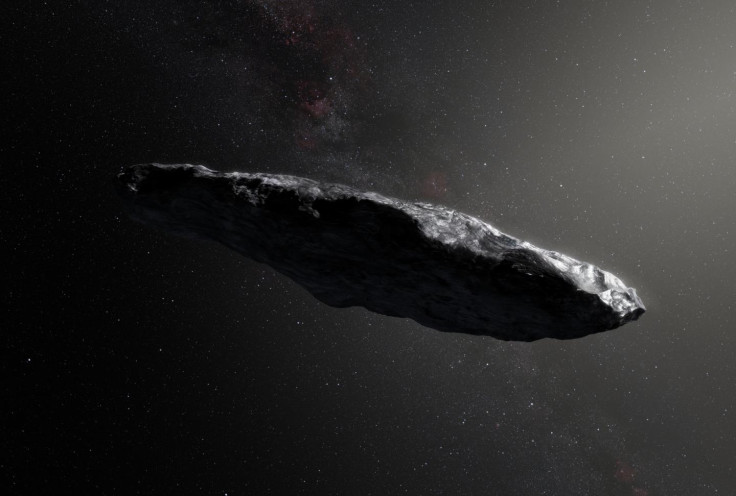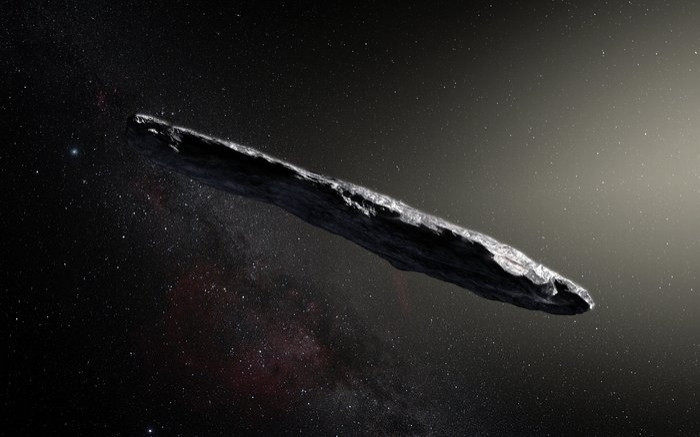Oumuamua: Alien probe, water ice or organic muck, what really is the first interstellar asteroid?
The first interstellar object that came toward the solar system is already on its way out, but what really is it?
The first known interstellar asteroid Oumuamua, which is moving through our solar system now, is an interesting case for astronomers and physicists as it is a mysterious object in every way imaginable.
Unsurprisingly, speculations about its origin, make-up, and even purpose are now flooding the internet. IBTimes UK lists out few such theories that are currently making the rounds.
Alien probe
Researchers at the Breakthrough Listen programme, an organisation that is dedicated to the search of intelligent life, honed in on the asteroid to look for signs of it being an alien probe. They scanned the rock for radio signals as scientists have maintained that a cigar or needle shape will be the most efficient way to design a spacecraft for interstellar travel. This could be one of the reasons why this asteroid was able to travel the many million kilometres it did to reach and now pass through the solar system.
An update to this story came from the Breakthrough Initiative as they released a statement saying that no radio waves or artificial signals were detected from Oumuamua.

Alien spaceship
Search for Extraterrestrial Intelligence Institute (SETI) was looking to see if the interstellar traveller was actually a spacecraft carrying aliens. After a lot of online chatter, SETI released a statement where they discussed the possibilities of Oumuamua being a hollow spacecraft. It came from the direction of constellation Lyra, home to the Vega star system which is just 25 light years away. For fans of sci-fi, the film "Contact" featured a SETI scientist who makes contact with an alien race from the Vega star system.
Naturally, it got people postulating. However, the SETI statement made it quite clear that there is no way to tell as Oumuamua is moving too fast away from the Earth. If it really was an alien craft, humans might never know.
Water ice
Did Oumuamua have water or at least watery ice in or on it? Scientists observing the asteroid did not notice any "outgassing" as it slingshot around the Sun, noted a report by the BBC. This indicates that there was no water on it. It could, however, contain frozen water inside itself if the outer shell of the rock was strong enough. It had a thick, outer shell made of carbon, notes the report. This shell could have formed as a result of millions of years of radiation and heating, say researchers. If the shell was a mere half-metre thick, it could possibly still hold water inside itself.
The way it reflects light is indicative of ice crystals that are found in the solar system in planets and moons that are covered in a dry crust. Also, the density of the asteroid is still unknown, so it is not possible to tell if it actually holds anything within itself.

Organic muck
New findings suggest that Oumuamua must have a carbon-enriched surface that is soft and marshy. Scientists say that if one were to stand on it, boots might actually sink into it like soft mud. Also, the core made of ice and water could keep it hydrated as well, notes a report published by Popular Science.
While the strength of this soft crust and texture are still pretty much unknown, the reddish colour of the asteroid could have come from the outer layer interacting with intergalactic radiation during its millions of years in travel.
Oumuamua's coating apparently grew about a foot and a half in the last 100 million years, says the report. On whether the muck contains any organic materials or possibly some form of life, the only answer is that we might never get to know.
Nobody knows where Oumuamua came from, only that it has been travelling between star systems for an inordinate amount of time, maybe millions of years, says Nasa. Its shape is unlike any asteroid that has been seen before. It is about 400 metres long and about 40 metres wide, giving it an elongated cigar-like appearance, and it is moving at speeds of over 200,000 kmh. It is also too fast to be captured by the Sun, so it will leave the solar system, never to be seen again. It was travelling toward Jupiter at the time of writing this piece.






















